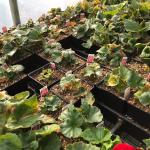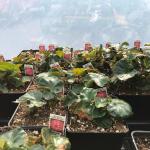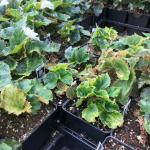Numerous challenges have been observed and reported over the last several weeks with begonia crops. In addition to environmental and cultural woes, begonia growers have been challenged this spring by broad mites, Botrytis, and INSV.
We reported on broad mites in our April 18 Greenhouse Update: http://ag.umass.edu/greenhouse-floriculture/greenhouse-updates-apr-18-2019
A number of begonia types, which are often prized for their foliage, are particularly susceptible to leaf spot diseases. The most common is a bacterial leaf spot caused by Xanthomonas campestris pv. begoniae. In addition to good greenhouse sanitation, one of the most effective practices for managing bacterial leaf spot is to minimize water splashing and leaf wetness duration. Begonias, therefore, are best suited to non-overhead watering methods, such as drip or sub-irrigation.
Sub-irrigation helps to reduce leaf wetness, especially during stretches of cool, rainy weather like we have experienced this spring, and the more precise watering helps to reduce the total greenhouse humidity load by limiting excess moisture. The lack of leaching, however, can result in elevated growing media EC, especially when fertility is not optimized and monitored closely and consistently. Fine, fibrous roots of begonia are very susceptible to damage from high substrate EC, particularly when plants are young and growing slowly.
Exacerbated by sensitive root systems, begonias are susceptible to root diseases, and wet, overcast weather increases root disease potential. Media should be thoroughly moist at the time of planting or sticking, ideally followed shortly thereafter by alternating wet/dry cycles. The prevailing weather pattern is not conducive to effective wet/dry cycling. Seeds or plugs planted in media that stays too wet for too long may have problems with rooting and root activity, and this can set the stage for problems throughout the entire crop cycle.
The cool, overcast weather that has dominated the region is perfect for Botrytis. Botrytis gray mold infects plants primarily through wounds or very tender tissue such as flower buds and leaf primordia, but once established it will progress, killing healthy and more mature tissue. Botrytis can be especially aggressive in over-fertilized crops.
Botrytis produces copious tiny spores. Although spore germination can occur at 33-86° F, the optimum range is 59-77° F. Spores need relative humidity (RH) >90% in order to cause infection, and they die rather quickly when they dry out. This is why some of the best prevention for Botrytis is to ensure that foliage remains dry. Be vigilant about ventilation, horizontal air flow, and reducing RH by heating and cooling. Remember also that the relative humidity within the crop canopy is likely higher than it is elsewhere in the greenhouse.
Monitoring for Botrytis and protective fungicide applications are crucial during wet weather, and it is helpful to have everyone working in the greenhouse on the lookout. Spanish-speaking employees may refer to Botrytis as "Moho gris" or "Botritis”.
INSV can cause a broad range of symptoms. In some cases it produces the classic ring spots and/or mottling associated with many viral diseases; in other cases, irregular necrotic lesions, stunting, and deformed leaves may be observed. In the latter scenario it may be easily mistaken for another disease, nutrient imbalance, or environmental issue. The virus can come into the greenhouse via infected plants or cuttings. Infected plants should be removed from the greenhouse and destroyed. INSV is vectored by several species of thrips, including western flower thrips and onion thrips, which must be controlled in order to prevent the virus from spreading. Weed management is also critical, as INSV has a wide host range and many weed species may harbor the virus.
Report by Angela Madeiras and Jason Lanier
Photos by Jeffery Vance, North Carolina State University


